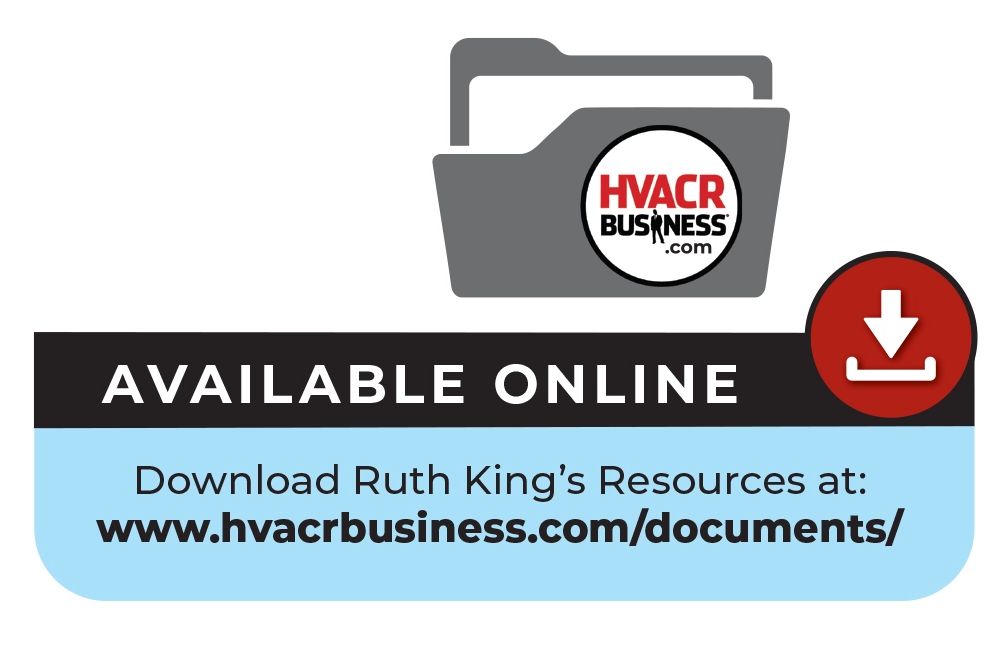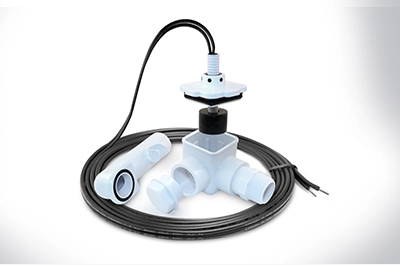Ruth King, best-selling author, and HVACR monthly columnist, is undisputedly one of the foremost experts on HVACR financial strategy. Throughout her time as our resident financial expert, we have included some invaluable downloads as complements to her columns to help you manage the profitability of your HVACR company. In this installment, we have pulled together the best of Ruth King finance – collated and researched for you (you’re welcome) – all in one place.
If you are an avid follower of Ruth King’s financial column, the following is an aggregated collection of the best downloads throughout the years. We’ve included summary snippets and the date it was published for reference. Whether you are a seasoned HVACR owner or just launching a start-up you will want to save this collection.
Building Your HVACR Business
(Tips for re-thinking your pricing policy and calculating your hourly rate)
Originally published July 2008
By Ruth King
If your sales closing rate is less than 30%, it’s time to improve your sales track record and increase your sales and closing rates. Continuous marketing is critical for lead generation – both service and installation. But in the tough times, you should continue marketing to your existing customers. Remind them why they need your services – to save money, decrease utility costs, etc. Now, if your field labor productivity is higher than 80%, your sales closing ratio is higher than 40% and you execute a continuous marketing plan, yet your financial statements are still showing lower profitability, then the answer to the question, “Should I raise my prices?” is probably yes.
The next question: “How much?”
From an installation standpoint, the how much answer depends on the increases in your direct costs and overhead costs. For replacement pricing, when you use a net profit per hour calculation, the price increases are easily calculated. If you want your net profit per hour to be consistent, add the overhead cost per hour, the total direct cost per hour, and the profit per hour you desire to arrive at the selling price per hour.
The total price is the selling price per hour times the total number of hours for each job. This assumes that you accurately determine the number of hours for each job. From a service standpoint, raising prices will be based on the formula sheet -- Calculating the Hourly Rate. Download here.
To Discount or Not to Discount
Originally published: 1/1/2009
By Ruth King
You'll often see terms from your suppliers that give you an incentive to pay their invoices early. This incentive is usually a one or two-percent discount when you pay the bill within a certain number of days. The question that normally races through your mind is: Is taking a discount good for me? To answer this question, you must balance the difference in your cost of money (i.e. what interest rate you can borrow at) with the value of the money when you get the discount. Let's assume that HVACR Supplier A offers you a discount of 1% when you pay in 10 days or requires full payment in 30 days. The interest rate for a short-term loan (or on your line of credit) is 8%. This calculation will help you determine when a supplier's discount is your best option. Download here.
The Annualized Interest from the supplier discount equals:
1%/100%-1% X 365/30-10
= 1%/99% X 365/20
= .010101 X 18.25
= 18.4%
Whether you should take a discount is totally dependent on the terms of the discount, your cost of borrowing, and plugging the numbers into the formula.
Ruth King’s 3 Rules to Understand Financials
From Stop Cutting and Start Growing
Originally published: 2/1/2012
By Ruth King
There comes a point where it is almost impossible to decrease overhead any further than you've decreased it. You've cut back on personnel, and everyone who is working at your company has taken a pay cut, including all owners. You've sublet space or moved into a smaller location, and you've cut every expense that could be cut. Yet, profitability still hasn't arrived. To calculate your monthly cash requirements, determine the percentage of sales that are collected each month and all monthly cash expenses. Divide the monthly cash expenses by the company's monthly gross margin. Then take this number and divide it by the percentage of sales that are collected each month. This gives you the sales that you must generate each month to cover the company's cash needs. Now, if you've cut all that you can cut, and you know you can cover sales and the monthly cash requirements, it's time to plan how your company can grow to cover its cash needs. Follow Ruth King’s 3 Rules to Understand Financials. Download here. Every HVAC owner should have this taped to their desk or saved to their mobile device.
Calculating Profit, Loss & the Labor Burden
From Where You Should Put Labor Burden
Originally published: 10/1/2015
By Ruth King
Some contractors state that the labor burden goes into the cost of goods sold because these expenses are paid for field employees. Other contractors put them in overhead costs. There is no right answer — and it doesn't matter when you price your service and replacement jobs using my net profit per hour method. Direct cost, or cost of goods sold, is a cost that is incurred when you sell something. Labor is a cost. But only labor expended on providing that service or performing that replacement.
If you put labor burden in direct cost, then whenever there is a training hour, a meeting hour, a vacation hour, a holiday hour, or any hour you pay where you could not bill a customer, that portion of "burden" has to go into overhead. In the larger picture, however, it doesn't matter where you put the labor burden when you price service and replacement using a net profit per hour calculation. True profit is determined by net profit per hour calculations considering both direct and overhead costs. Labor burden is included, whether you put it in direct or overhead cost. Decide how much you want to earn for every billable hour your company has. Then add the overhead cost per hour and the direct cost of the job. It's that simple. Download here.
The Weekly Cash Report
From the Stupid Things Series
Originally published: 5/5/2022
By Ruth King
In 2022, Ruth King wrote a Stupid Things Series all about stupid mistakes contractors make and how to avoid them. It was an extremely popular run partly because she included downloads as a complement to the columns. In this article from May 5th, 2022, King warned contractors to protect their profitability and cash – in other words, don’t do stupid things. The weekly cash flow document ran as a download to utilize as a learning tool. This is the report that the bookkeeper provides to the contractor every Friday afternoon and it’s essential to understand your profitability.
We think it is a great place to start protecting that cash flow. In case you missed it, here it is again.

We hope you found these downloads helpful. Keep reading future issues written by Ruth King – there are more great tools coming up, including actual excerpts from her most recently published book!
Ruth King has more than 25 years of experience in the HVACR industry and has worked with contractors, distributors and manufacturers to help grow their companies and become more profitable. Ruth has written several books and has a new one hot of the press. Click Here to order. Contact Ruth at ruthking@hvacchannel.tv or at 770-729-0258.








